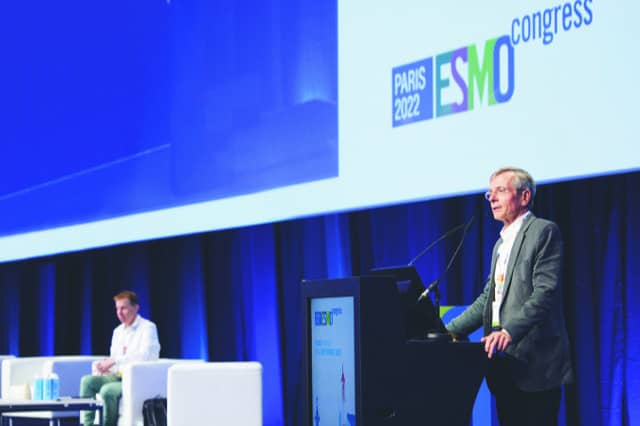

Standing ovations at medical congresses aren’t an everyday event, but they’re becoming a trend in cancer research. The European Society for Medical Oncology (ESMO) held its 2022 congress in Paris in September. And just like ASCO’s Chicago equivalent a few months earlier, the scientific innovation on display was enough to make delegates rise up from their seats.
ESMO didn’t quite match the whooping and hollering seen in Illinois, where one particular presentation inspired a raucous ten-minute ovation. But it showed enough to confirm that these are exciting times in cancer research. And, in the post-COVID era of hybrid events, it reaffirmed the value of traditional medical congresses, highlighting a renewed opportunity for creative comms to play an even bigger role in transforming oncology care.
As ever, the ESMO programme and accompanying exhibition was rich and diverse, running the full gamut of the oncology category. It was impossible to see everything. However, the experience revealed three broad trends.
1. The crowds are coming back
This was ESMO’s first in-person congress since the pandemic disruption and the crowd numbers suggest that delegates aren’t yet persuaded to trade their lanyards for a virtual pass. In-person attendance was impressive. ESMO says there were 22,000 registered participants and although we don’t know what proportion were online, the on- site experience showed that many were physically present. Anecdotally, some attendees felt that in- person numbers exceeded ASCO 2022, although the Presidential Symposia at the latter generated two full auditoria whereas ESMO’s didn’t quite reach capacity. Either way, the trend is clear – the crowds are coming back and that can only bode well for clinical practice.
The return to in-person congresses has positive implications across the board, not least from an industry comms perspective. In-person attendance naturally leads to greater exhibition presence, more ad boards and more satellite symposia. These are huge engagement opportunities and a chance for creative comms to galvanise learning. However, the nature of that engagement has undoubtedly been changed by the COVID-19 experience, creating a conundrum for medical associations, industry and agencies as we look to drive healthcare professional (HCP) interaction in a new world.
The next model of medical congress will inevitably retain the hybrid mix of online and in- person engagement, but the balance of that mix may need to change to incentivise and maintain physical attendance. Could organisers evolve to a model where the presentation of key data is only available on-site rather than remotely? Time will tell. It’s a trend that will be interesting to follow as more in-person activities resume. For now, there’s a big creative opportunity for industry to raise the bar of congress engagement to support both sides of the hybrid model.
2. Innovation: incremental, but incredible
Compared to ASCO, ESMO 2022 didn’t deliver so many major ‘practice-changing’ moments.
In Chicago, the presentation of the DESTINY- Breast04 study, which established a new standard of care and improved progression-free and overall survival for patients with HER-2-low metastatic breast cancer, drew a long, Oscar-like ovation from the whole audience. At ESMO, nothing quite scaled those heights, although the NICHE-2 study in mismatch repair-deficient (dMMR) colorectal cancer (CRC) showed impressive results, earning applause from the audience.
In the main, though, ESMO showcased incremental advances on ASCO data along with some very interesting new studies. Headline takeaways include:
Enhertu is centre stage and gathering momentum
Enhertu was very present at ESMO, with its potential application getting earlier and broader. AZ/Daiichi Sankyo’s great hope took centre stage, with increasingly strong data in earlier lines and across different HER-2 cancers expressing different levels of HER-2. This really does represent the next generation of antibody-drug conjugates (ADCs) via its significant bystander effect, and with potentially new targets and payloads (for example HER3 in lung cancer) to come. Toxicity is now more manageable and primary or acquired resistance mechanisms still don’t appear to be a major problem or well understood. Based on the results we have seen with immune checkpoint inhibitors (ICIs), it will be interesting to see how T-DXd performs in the neoadjuvant setting. Accurately assessing HER-2 expression is an ongoing discussion with potential for artificial intelligence and machine learning solutions.
Immuno-oncology remains key
The promise of immuno-oncology (IO) shows no sign of abating, with current efforts focused on increasing responder rates. Neoadjuvant and first- line IO with checkpoint inhibitors continues to bring benefits across responsive cancers, and there is now significant data on new IO combinations to improve response rates and reduce toxicity, including innovative bispecific monoclonal antibodies and Bi-specific T-cell engagers.
In terms of established IO combinations, as noted earlier, impressive results were presented from the NICHE-2 neoadjuvant study of nivolumab/ipilimumab in MMR-deficient CRC (approximately 15% of patients), which resulted in a 95% major pathological response and 67% complete response, with no disease recurrence at 13 months’ follow-up. This is practice- changing in this population of patients and reinforces the importance of biomarker testing and personalisation of treatment. Sequential immunotherapy and targeted therapies are also demonstrating clinically meaningful survival benefits, such as for patients with BRAFV600- mutant melanoma in SECOMBIT.
However, some advanced cancers are certainly less responsive to first-line immune checkpoint inhibitors or even first-line immune checkpoint inhibitors in combination with antibody-drug conjugates, such as in advanced urothelial cancer. Here, chemotherapy followed by first-line PD-L1 maintenance therapy is now clearly established as the standard of care.

Above: John Haanen, Netherlands Cancer Institute and Professor of Translational Immunotherapy of Cancer at Leiden University, was scientific co-chair of ESMO IO Congress from 2016-2019, and Scientific Chair of the ESMO 2020 Congress
Tumour-infiltrating lymphocytes (TILs) have come of age
A related IO technology aiming for more durable/ curative responses was evaluated in the first randomised study vs anti-CTLA-4 in anti-PD-1 refractory metastatic melanoma. The conclusion? The technology works but it’s still not mainstream because of the need for conditioning and hospitalisation for patients. However, the data is very impressive in patients no longer responding to checkpoint inhibitor blockade and building on this technology may bring more accessible treatments.
The real value of real-world evidence in advanced breast cancer
Real-world evidence (RWE) is playing an ever- increasing role in treatment decision-making, in all forms of cancer. The first approved CDK4/6 inhibitor, palbociclib (IBRANCE) showcased the most comprehensive first-line comparative real-world study at ESMO Breast 2022, where it demonstrated a significant overall survival (OS) benefit in John Haanen, Netherlands Cancer Institute and Professor of Translational Immunotherapy of Cancer at Leiden University, was scientific co-chair of ESMO IO Congress from 2016-2019, and Scientific Chair of the ESMO 2020 Congress combination with endocrine therapy and followed this up at ESMO 2022 with further RWE showing stable maintenance of quality of life in patients with advanced breast cancer receiving this treatment.
Galleri made the gallery – it works, but can we afford it?
Galleri multi-cancer early detection (MCED) blood testing data was presented at ESMO, supporting the accuracy of this technology. MCED uses circulating tumour DNA (ctDNA) methylation patterns to evaluate the potential presence of cancer. In the PATHFINDER study, the MCED test detected a cancer signal in 1.4% of 6,621 people aged 50+ years not known to have cancer, and cancer was confirmed in 38% of those with a positive test. Of the 6,290 people who were cancer free, 99.1% received a negative test result. This will have significant implications on the increased diagnosis of cancer, which can only be a good thing given that early diagnosis is generally associated with better outcomes. However, the advance is not without challenges, bringing into sharp focus the need for healthcare systems to ensure they have the resources and wherewithal to manage the expected rise in patients with early cancer diagnoses.
3. Digital health and advances in cancer are a perfect match
Another compelling trend evident at ESMO 2022 was the increased focus on digital health and its growing application in oncology. It’s clear that the future advances that transform cancer care will most likely be underpinned by digital innovation such as AI and machine learning. This was certainly reflected on the conference stage where numerous presentations reported a growing openness towards the use of AI in diagnosis and treatment. We’ve come a long way in the ten years since IBM Watson was first used to support decision-making in lung cancer care. Today, digital health tools are supporting everything from drug development and clinical trials to diagnostics, treatment, radiology and pathology.
ESMO highlighted how, in an age where cancer medicines are becoming increasingly personalised, AI is helping to accelerate the identification of patients with ultra-specific (and often ultra-rare) cancer types.
Pharma’s investment in immuno-oncology, cell therapies and antibody-based therapies epitomise the drive to personalise medicines and transform survival rates. But, as was made clear at ESMO, it’s an investment that’s being matched by a commitment to digital health. Industry, in partnership with academia, is throwing the kitchen sink at digital innovation to develop clinical trial ‘best match’ algorithms (based on biomarkers), best match treatments and better personalised care. One of the big headlines coming out of ESMO 2022 is that these algorithms should be available by 2025-2030. That will only mean that the incremental innovation currently being showcased will, in time, yield even better results.
The take-home? The true promise of digital health has not yet been realised, but evidence increasingly suggests it’s the perfect match for cancer care. ESMO showed that the broad umbrella of digital health is enhancing research, enhancing treatment and, best match of all, enhancing patient outcomes.
Closing remarks
For the first time in over three years, ESMO 2022 brought the European cancer community together for a much-needed plenary. It revealed an oncology category that may have been light on face-to-face engagement, but that hasn’t stopped it being rich in therapeutic advances. There was so much to applaud. And so much more to come that will bring the crowd to its feet.




